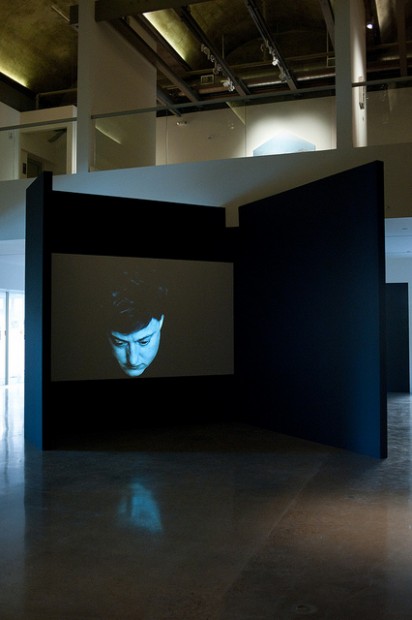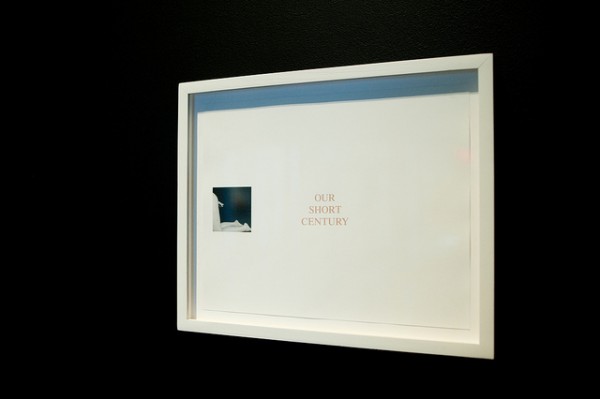Emily Roysdon is an artist who lives in Stockholm and New York, when she’s not traveling around the globe, mounting collaborative and site-specific projects. Roysdon was an artist in residence at the University of Texas’s Visual Arts Center this fall, where she developed the installation Pause, Pose, Discompose. While she was in the midst of the project, I sat down with her to discuss collaboration, the act of telling and improvisation as practice.
Katie Geha: I first got interested in your work through my former professor Greg Borodowitz, who was a huge fan of LTTR (Lesbians to the Rescue). He introduced me to your David Wojnarowicz piece. I really love that project.
Emily Roysdon: Thanks! It was one of the first things I ever made and I just had the extreme honor of selling that to the New York Public library. I don’t have a commercial life and I don’t normally sell things. They have an extraordinary collection.
KG: Right, you don’t necessarily work with objects, hence not having a traditional art career.
ER: Not so much. I have made a few photographs and I really like working with prints. But I haven’t prioritized objects in any way. I haven’t made those concessions to the way the art world does work or should work.
KG: But didn’t LTTR often produce publications?
ER: Yes, but they were ten dollars. I loved them and I loved those collating parties. They were some of my favorite days of my life. It was just such fun work.
KG: Are you not tied to objects because of your need to work discursively? Is it political? Against a specific notion of art making? Or is just the way you work?
ER: It’s several things. In the beginning, the way that I was able to become an artist was being part of LTTR—that strong identification and community and collaboration. In those years I had already made the David Wojnarowicz project but hadn’t made many things. Quite simply, to be frank, I never had money to make things. I hadn’t gone to art school so I didn’t have the sense of materials and investment and all this kind of stuff. For me, it’s always been about labor and discourse. I would love to have a studio. But I don’t have one.

Installation view of “Emily Roysdon: Pause, Pose, Discompose” at the Visual Arts Center in the UT Department of Art and Art History. Photo credit: Sandy Carson
KG: I don’t think of you as a studio artist, necessarily.
ER: But I would still love to have one. It’s so important for me to spend time alone. Like I need to write this week. That will determine whether this video works or not. And in so many ways I would love to have a studio as just a place, as a location for my processes. But almost more, I’d love to have a studio for history. I sometimes forget what I’ve ever done before. Each time I start, it’s like I’m starting from zero. I have to decide again that I want to be an artist. I have to decide again that I like cameras as tools.
KG: I never feel like your work is really about beginnings and endings, somehow it feels more fluid to me. But at the same time what you just said is that you keep having to start “new.” So are your projects independent from one another? Is what you are doing at the VAC not related to past projects? Do you have to start with a new vocabulary each time you do a project?
ER: It is very much about vocabulary and that is what carries forward, and the tools too. It’s interesting for me to look back and see how all of these things have been connected for several years. I’ve had these spurts of working very hard these past few years and I can start to see how things are accumulating. I can understand what my process is and trust it.

Installation view of “Emily Roysdon: Pause, Pose, Discompose” at the Visual Arts Center in the UT Department of Art and Art History. Photo credit: Sandy Carson
KG: It’s clear that text and the act of writing plays a central role in your work. In Ecstatic Resistance you also talk about the idea of telling, which is really compelling to me. Is there a difference between writing and telling?
ER: That’s a very interesting, complicated question. Something I actually heard from Gregg Bordowitz is that whenever he is writing, he is writing to someone. He is writing to one person in particular. I always found that really useful because the way I learned how to write, or taught myself how to write, or began writing, was in LTTR. I think I had a sort of confidence or willingness to be experimental because I thought I knew who I was writing for . . there is always someone on the other end. The telling is about the encounter.
KG: A type of correspondence occurs in both?
ER: Well, the real difference is that writing is visual and telling is aural. Also in telling, there is a desire. It’s not a confession because that involves guilt and confusion. Telling is a desire to speak.
KG: What about movement, then? Is it a desire to move or does space instigate movement? Or is it that space dictates movement? I’m thinking about your project in Stockholm or maybe how students walk through the VAC more as a shortcut than an intention to look at art.
ER: Theoretically, movement is at the center, it’s very close to language. It’s how I think through both formal concerns and political concerns. I don’t feel like a choreographer, but I think endlessly about choreography. I’m not a dancer but I do projects where I ask people to move. So it’s not a desire to move as much as it is a desire to think about movement.

Installation view of “Emily Roysdon: Pause, Pose, Discompose” at the Visual Arts Center in the UT Department of Art and Art History. Photo credit: Sandy Carson
KG: At the VAC you seem to be figuring out the project on-site. How does the space and university context inform the project?
ER: It is very context-specific. I’m very sensitive to space. I don’t take walls or exhibition space for granted. There’s always something I need to do to the space so my work can live. So in that way, it’s very specific to the context and space, and this is the biggest room I’ve ever had to deal with. And the height, it’s really something! The other parts are relationships and friendships and being able to come to a place like Austin and tap into a queer community and see people I haven’t seen in a few years, to do a project together. That’s the pleasure in the kind of work that I do. I like to go to a new place and figure out how to do things with people.
KG: So the space of the VAC is one aspect, but it also seems like living in Austin and figuring out the project is another.
ER: Going back to the schema for Ecstatic Resistance, which I did not develop to explain my own work, but it does intersect with my interests. At the center of that schema, movement is at the core and struggle and improvisation are pyramids that face one another. So I have been theorizing improvisation. This project is very much about improvisation. That I am going to come here for four days and I am going to do a video shoot then edit, print and install in two weeks. It’s a huge challenge.
KG: So the improvisation of creating becomes part of the piece?
ER: Yes, and I’ve had to look at myself and realize that I like limitations. I also like working on a human scale, in a livable scale. I like reaching for something but then accepting the thing that is closest. Doing this project within three weeks keeps things within the realm of possibility and limits of relationships.
Emily Roysdon: Pause, Pose, Discompose
UT Visual Arts Center
September 21 – December 8, 2012
____________
Katie Geha is a writer, curator and art historian living in Austin, Texas. She grew up in Ames, Iowa and received her MA in art history from the School of the Art Institute of Chicago and her PhD in art history from the University of Texas, Austin.



